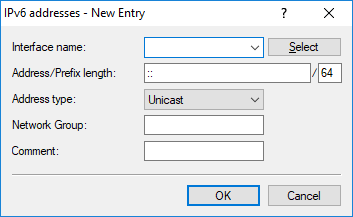The IPv6 addresses table is used to create IPv6 addresses for LAN and WAN interfaces.

Entries in the IPv6 addresses table have the following meaning:
- Interface name
- Give a name to the interface that you want to assign the IPv6 network.
- Address / prefix length
- Specify an IPv6 address including the prefix length for this interface.
The default prefix length is 64 bits ("/64"). If possible do not use IPv6 addresses with longer prefixes, as many IPv6 mechanisms in the device (e.g. auto configuration) are designed for a maximum length of 64 bits.
Example:
- Global unicast address: 2001:db8::1/64
- Unique local address: fd00::1/64
Note: Link-local addresses are fixed and not configurable. - Address type
- Specify the type of IPv6 address.
Options:
- Unicast With the Unicast address type, you use the Address/prefix length field to specify a full IPv6 address along with its interface identifier, e.g. "2001:db8::1234/64".
- Anycast With the Anycast address type, you can also use the Address/prefix length field to specify a full IPv6 address along with its interface identifier, e.g. "2001:db8::1234/64". Internally, the device handles this address as an anycast address.
- EUI-64 With the address type EUI-64, IPv6 addresses conform to the IEEE standard "EUI-64". The MAC address of the interface thus forms a uniquely identifiable part of the IPv6 address. The correct input format for an IPv6 address including the prefix length as per EUI-64 would be: "2001:db8:1::/64". EUI-64 ignores any value set as "interface identifier" in the corresponding IPv6 address and replaces it with an interface identifier as per EUI-64. The prefix length for EUI-64 must be "/64".
- Delegated Auto ConfigurationThe IPv6 address is formed from the router advertisement prefix received on the selected interface (Interface name field) and the host identifier from the field Address / Prefix length. The field Address / Prefix length can be filled out e.g. with the value "::2/64" in combination with the prefix "2001:db8::/64" on the interface to form the address "2001:db8::2/64".
- Delegated DHCPv6The IPv6 address is formed from the delegated DHCPv6 prefix received on the selected interface (Interface name field) and the host identifier from the field Address / Prefix length. The field Address / Prefix length can be filled out e.g. with the value "::2/64" in combination with the prefix "2001:db8::/56" on the interface to form the address "2001:db8::2/64". Similarly, an address can be formed from any subnet of the delegated prefix, e.g "0:0:0:0001::1" and the prefix "2001:db8::/56" go to form the address "2001:db8:0:0001::1/64".
- Network group
- Enter a descriptive name for this combination of IPv6 address and prefix. This label of the network group does not have to be unique. Consequently, several different prefixes can belong to a network group. The network group can be referenced in the IPv6 firewall in the station table under in the field Network name if the Type there is set to "Named network". The station then consists of all prefixes in this network group. Furthermore, you can reference it in the VPN in the table in the field Local networks. As a result, all prefixes of the network group end up on the local side of the network relationship.
- Comment
- Enter a descriptive comment for this entry.
